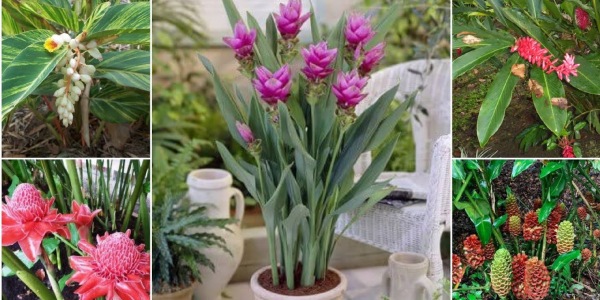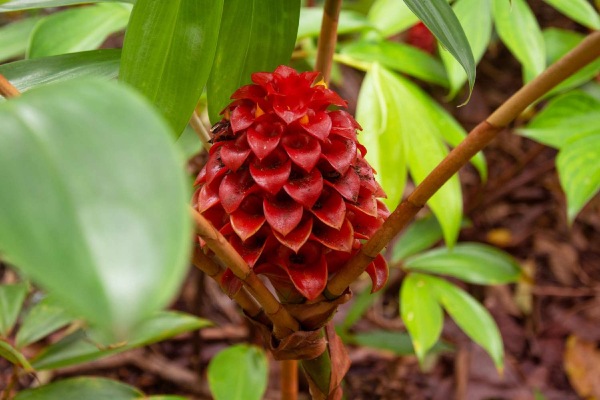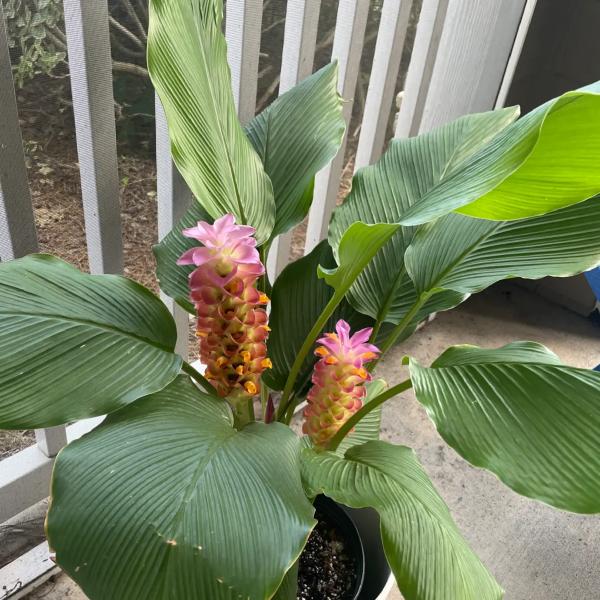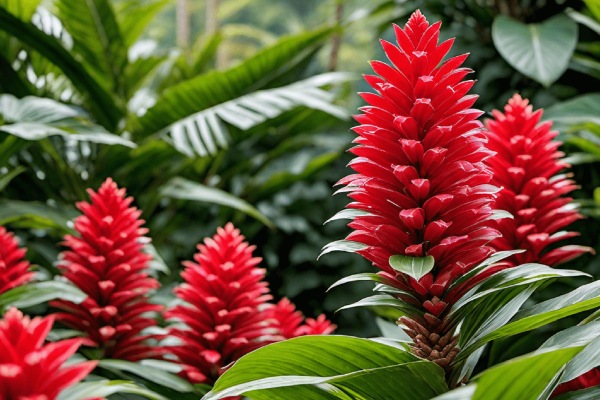Flowering Ginger is also referred to as Ornamental Ginger. It is a popular tropical garden plant known for its beautiful, fragrant flowers and foliage. Unlike edible gingers, ornamental ginger is grown mainly for its decorative appeal. Growing Ginger can be quite rewarding, especially when these plants produce colorful, fragrant blooms. However, you also need to have the patience to grow this plant because it may take a few years for some varieties to bloom. You can grow ginger directly in your garden or containers. However, your ginger plant does require the most optimal conditions for growth including light, warmth, humidity, and nutrients.
Below, you will find additional information about Flowering Ginger to guide you in achieving successful growth.
Plant Descriptions
Plant Type: Herbaceous, perennial
Scientific Name: Zingiber spp.
Family: Zingiberaceae
Common Name: Flowering ginger, ornamental ginger, ginger
Season: Summer, Fall
Native Area: Asia
Ornamental Ginger Plant varieties
Ornamental ginger is a large group of plants with around 47 genera and over 1,000 species. Below are some of the stunning flowering varieties that can make your garden look like an exotic paradise.
Shell Gingers
Shell Ginger, scientifically known as Alpinia zerumbet, is the most common type of species. This plant is mainly grown for its eye-catching foliage, which features bright green and gold colors. Its flowers are typically white with a pink or orange throat, but they are not as visually striking as those of Torch or Beehive Gingers. Shell Ginger has a strong, upright growth habit and is often found growing as an under-story plant or near watercourses. This tall plant species generally thrives in partial shade but can also tolerate full sun in cooler climates. In warmer areas, it does best with morning sun and afternoon shade.
Crepe Ginger
Crepe Ginger, scientifically called Costus speciosus, is a large, long-lasting herb that can grow 3m tall. Its leaves are shaped like oblongs or lances and are arranged in a spiral pattern along its reddish, thin stems. The plant produces dark red, rounded clusters of flowers. Each flower is white, funnel-shaped, and has petals that look like crinkled tissue paper. The flower also has a yellow center that appears between the bracts. Crepe Ginger grows best in bright, indirect light but can also handle light frosts to some extent.

Butterfly Gingers
It is also referred to as white ginger lily, butterfly ginger, or garland and its scientific name is Hedychium Coronarium. Butterfly Gingers have large, lance-shaped leaves that are medium green in color. They produce fragrant white flowers in dense, elliptical clusters. These flowers bloom from late summer to early fall, and the plant is popular for its sweet-smelling white flowers. Butterfly Gingers grow well in partial shade to full sun, but in hotter climates, they need protection from the strong afternoon sun. In their native habitat, the plant can grow as tall as 10 feet, though it typically reaches 3 to 6 feet in height.
Pineapple Ginger
Pineapple ginger, which is scientifically named Tapeinochilos ananassae, has a striking appearance that resembles a pineapple. However, unlike a typical pineapple, this plant is red. This plant is originally from the Spice Islands of Indonesia, New Guinea, and Australia. It thrives in warm, humid environments but is sensitive to cold. Pineapple ginger produces bright red flowers and can stay fresh for more than six months. The plant also has twisted leaves and reddish stems that look like bamboo. It can grow well in both full sunlight and partial shade, but it needs consistent moisture throughout the year. It should be planted in a soil mixture made from equal parts of pine bark mulch, peat moss, and good-quality topsoil for the best growth.
How long does it take to bloom your Flowering Ginger?
If you are concerned that your flowering ginger isn’t blooming, then you must know it takes at least a year, sometimes even more than that, to bloom. Also, if your plant is mature and still not blooming, it might be because of a lack of lighting. When they don’t get enough light, they may not bloom or may grow poorly. In addition, low temperatures or humidity can also make the plant either fail to bloom at all or go dormant. Make sure the humidity is high and let the temperature stay above 50°F. Another reason for poor blooming could be a lack of nutrients in the soil. For that, you should use a certain amount of balanced fertilizer every other month, or organic matter like compost or manure. Also, be careful not to overwater or let the plant sit in waterlogged soil, as this can cause yellow leaves and root rot.
How do you care for the flowering ginger plant?
This plant tends to grow vigorously and can sometimes spread across garden areas. Therefore, it’s best not to plant it near natural areas where it might spread too much. Although flowering ginger is usually easy to care for, here are some tips to help you grow it successfully.
Light
Choose a location where it gets partial shade or filtered sunlight throughout the day. If the plant does not receive enough light, it may struggle to bloom. Similarly, if the plant gets too much direct sunlight, its leaves might get brown edges. Some ginger varieties can handle full sunlight in cooler areas, but you should always check the light requirement of the specific variety you are growing.
Soil requirements
Flowering ginger grows best in soil that is moist, well-drained, and rich in organic matter. If you have clay soil, mix in gypsum to improve drainage. Additionally, you can use organic mulch, such as wood chips or pea straw, to help retain moisture. However, give attention to keeping the mulch away from the base of the plant to prevent rot.
Watering needs
Water frequently during the growing season depending on weather conditions, less often in fall and winter. Weekly deep watering is preferable to shorter daily showers. Aim to give your ginger plant approximately one inch of water per week.

Temperature and Humidity
Ginger plants grow best in temperatures between 70° and 80° F (21° to 27° C). While some hardier varieties can handle brief frosts down to 50° F (10° C), it is best to keep them away from frost. In colder areas, consider growing ginger in pots that you can bring indoors during winter.
Similarly, tropical ginger plants thrive in high humidity, between 60 to 80%. If the air gets too dry, they might stop flowering or even go dormant. To boost humidity in dry climates, you can mist the plants, place a tray of water under the pots, group the plants together, or use a small nearby fountain.
Fertilizer
Feed your ginger plant every other month to keep it healthy. Since ginger plants need a lot of nutrients, give them a shovelful of manure every two weeks during the summer. Alternatively, you can use a complete flower fertilizer once every two months. However, make sure to follow the instructions on the product label for the right amount to use.
Pruning
In the spring, make sure to prune the plant thoroughly before new growth begins. After the ginger plant has finished blooming, cut the flower stalks back to the ground. You can compost the leftover fleshy cuttings and replant any new rhizomes. During the growing season, it is also a good idea to remove any dead or damaged canes to keep the plant healthy.
Common pests affecting Flowering Ginger and How to stop them
Flowering ginger can be affected by various pests like aphids, ants, soft scales, mealybugs, and red spider mites. Pesticides should be used to control these pests. However, there are some ways to control some pests without using harsh chemicals. For example, you can release ladybugs to feed on aphids or sprinkle diatomaceous earth to get rid of snails and slugs. Similarly, you can remove dead leaves and rotting parts of the plant.
In addition to pests, flowering ginger can get two common diseases, bacterial wilt and fusarium yellows. Both diseases cause the leaves to turn yellow and the plant to wilt, but bacterial wilt spreads faster. To identify the disease, check the rhizomes for signs like wet, mushy spots or sticky substances from bacteria, or dry, rotting areas for fusarium yellows. Unfortunately, the only way to treat these diseases is to remove the infected plant before it spreads.
How to Propagate a Flowering Ginger Plant
Flowering ginger is easy to propagate by the division of an existing plant. This is best done in the springtime of the year because this provides the best conditions for growth with its longer daylight hours and warmth that help keep it healthy and strong. Here is a step-by-step guide that helps your ginger plant grow well and eventually bloom.
Step 1: Dig up the rhizomes and cut them into 1- to 2-inch pieces. Make sure each piece has a few healthy growth buds.
Step 2: Take a pair of clean, sharp scissors or pruning shears. Sterilize the shears first to avoid spreading diseases to the ginger.
Step 3: Allow the cut pieces to dry one day. Select a pot at least 300 mm wide and deep.
Step 4: Fill the pot with good-quality potting mix and plant the rhizome pieces just below the surface in rich, well-drained soil.
Step 5: Place the pot in partial shade to match its natural growing environment. Water lightly until new growth appears.
Step 6: Once the plant is established, water more deeply and fertilize every 6-8 weeks from spring to autumn.

Also read, Basil Plant Flowering? Here’s What You Need To Do
Frequently Asked Questions
1. Is Flowering Ginger edible?
Flowering Ginger is mainly grown for its decorative appeal rather than for consumption. However, some species of Flowering Ginger including Butterfly Ginger. For example, its roots and blooms are reported to be edible.
2. How do I get my ginger plant to bloom?
To help your ginger plant bloom, make sure it gets enough light, warmth, and humidity. Fertilize it regularly and keep the soil moist. Also, protect the plant from frost and ensure it has well-drained soil.
3. How do I care for my Flowering Ginger during winter?
In winter, protect your Flowering Ginger from frost. In colder climates, consider moving the plant indoors or into a greenhouse. Reduce watering and avoid fertilizing during the plant’s dormant period.
